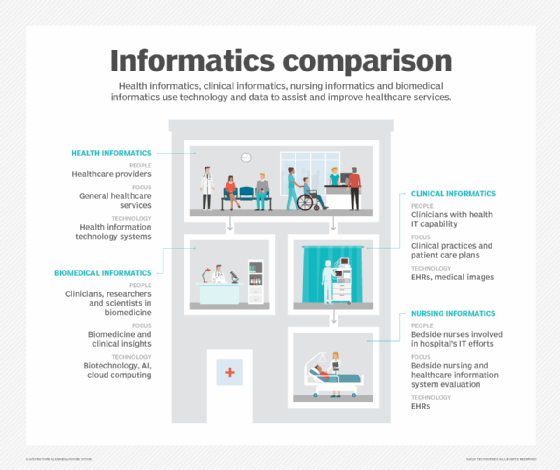health informatics
Health informatics is the practice of acquiring, studying and managing health data and applying medical concepts in conjunction with health information technology systems to help clinicians provide better healthcare.
Health informatics, sometimes known as healthcare informatics, has grown as an evolving science with the expansion of electronic health records (EHRs) and health data analytics systems. It has also grown with the establishment of health data exchange standards, such as HL7 (health Level 7) and FHIR (Fast Health Interoperability Resources) and clinical health terminology sets like SNOMED CT.
Clinical informatics
Clinical informatics is used in direct patient care by supplying physicians, nurses, physical therapists, aides and other caregivers with information that can be used to develop a care plan. Clinical informaticists analyze data or medical images or help clinicians to retrieve that information.
They can also develop interfaces to health IT systems to help clinical caregivers more easily view and use health data.
Nursing informatics
Nursing informatics is another kind of health informatics that encompasses nurses' interactions with health IT systems. The field has become more important as most healthcare systems and physician practice facilities have put their patient records online and entrusted their nursing teams to handle transition-of-care situations in their EHRs.
Nursing informatics specialists try to accurately document transitions of care -- for example, when a patient is going from an ambulatory setting to a hospital setting, or from a hospital to a rehabilitation center. Often, this is required by Medicare or private insurance reimbursement program criteria.
As with clinical informatics, nursing informatics is still growing as an educational field in which students can receive academic certificates and degrees.

The chief medical information officer
In many organizations, the chief medical information officer (CMIO) may also be known as the director of health informatics or the director of medical informatics. CMIOs are responsible for designing and integrating technology into physicians' workflows, and they straddle the medical and technological sides of medicine, serving as intermediaries between physicians and the IT department.
The duties of a chief nursing informatics officer (CNIO) can overlap with those of a CMIO. The CNIO role is typically more targeted at evaluating products and developing a workflow within which nursing teams can effectively use the technology they most commonly work with, the EHR system.
Public health informatics
Public health informatics is the application of computer science, information and technology to the administration of public health, including disease surveillance, prevention, preparedness and health education, according to the American Medical Informatics Association.
When used in public health, informatics guides government and nonprofit health administrators in making data-driven decisions about public health policies and programs, such as clinical data registries and chronic disease prevention.
Education needed
Some colleges and universities now offer specialized bachelor's degrees in health informatics. A master's degree in health informatics is also available at some schools. Degrees in healthcare information management are also good preparation for jobs in the field.
Trends for the future
Health data analytics experts who can track and draw insights from health informatics information are of increasing value to the population health management programs that healthcare systems use to track and improve the condition of people with chronic conditions like diabetes, hypertension and obesity.
Healthcare providers can also use this information to document their efforts and report to federal health agencies, such as the Centers for Medicare & Medicaid Services.
Health informaticians are also increasingly using technologies such as machine learning to perform predictive analytics about the likelihood of individual patients and larger patient populations getting certain diseases, as well as their outlook for treatment.

Development as a field
The first practical use of health informatics was in the 1950s with dental data collected by the National Bureau of Standards, now known as the National Institute of Standards and Technology (NIST). The field expanded significantly in subsequent decades following the development of the Massachusetts General Hospital Utility Multi-Programming System, which provided a standard programming language for clinical applications. Today, the International Medical Informatics Association (IMIA) oversees member organizations involved in health informatics worldwide.







